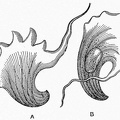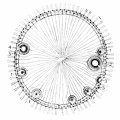15/19
The amœba is one of the simplest of all animals, and gives us a hint of the original ancestors. It looks like a tiny irregular speck of greyish jelly, about 1/100th of an inch in diameter. It is commonly found gliding on the mud or weeds in ponds, where it engulfs its microscopic food by means of out-flowing lobes (PS). The food vacuole (FV) contains ingested food. From the contractile vacuole (CV) the waste matter is discharged. N is the nucleus, GR, granules.
- Author
- The Project Gutenberg EBook of The Outline of Science, Vol. 1 (of 4), by J. Arthur Thomson
Published in 1922
Available from gutenberg.org - Posted on
- Thursday 16 July 2020
- Dimensions
- 894*1074
- Tags
- Albums
- Visits
- 657
- Downloads
- 46
 Download Photo
Download Photo





